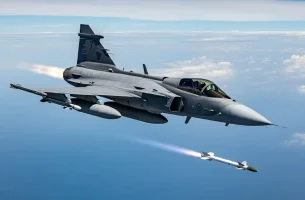- Views: 4K
- Replies: 29

As the Indian Air Force (IAF) moves closer to procuring 114 Multi-Role Fighter Aircraft (MRFA), Swedish defence giant SAAB has entered the fray with a compelling offer centered around its Gripen fighter jets.
SAAB is emphasizing not only the advanced capabilities of its Gripen-E and Gripen-F variants but also a commitment to establishing a robust production and technology transfer ecosystem within India, aligning with the nation's 'Aatmanirbhar Bharat' initiative.
SAAB is highlighting the Gripen-E's cutting-edge technology, including advanced avionics, a powerful GE FE14G engine, and versatile payload capabilities.
Kent-Ake Molin, Head of Gripen for India Programme, emphasized the jet's advanced Human Machine Collaboration (HMC), stating, "We envisioned Gripen E to be an extension of the pilot's mind and body, and we achieve it through advanced Human Machine Collaboration (HMC)."
This HMC, coupled with a redesigned cockpit featuring a hands-on-throttle-and-stick (HOTAS) setup, aims to enhance pilot situational awareness and reduce workload.
Beyond its HMC, the Gripen-E boasts a new AESA radar, increased fuel capacity, and integration of Artificial Intelligence (AI) to provide pilots with real-time, mission-critical information. SAAB is also promising a rapid delivery timeline, claiming it can deliver the first batch of fighter jets within three years of securing the contract.
A cornerstone of SAAB's proposal is the commitment to local production and technology transfer. Drawing on its experience establishing a Gripen production line in Brazil, Molin stated, "We have already established a supply chain in India, and we are looking to gear up and see how we can build or establish a supply network for Gripen in India, to be made in India, being part of the Gripen industrial global system and also to export to other nations."
However, SAAB's bid faces challenges. The Gripen relies on foreign OEMs for key components like engines and radar systems, potentially hindering India's self-reliance goals.
Furthermore, the success of technology transfer and local production hinges on effective collaboration with Indian companies and navigating the complexities of the Indian defence landscape.
India's commitment to its indigenous Light Combat Aircraft (LCA) Tejas program also poses a challenge to the Gripen's prospects.
Despite these hurdles, the Gripen-E, with its advanced technology and the promise of local production, represents a strong contender in India's MRFA competition.
The final decision will depend on a careful evaluation of the Gripen's capabilities, SAAB's ability to deliver on its promises, and the alignment of the offer with India's long-term defence objectives.


